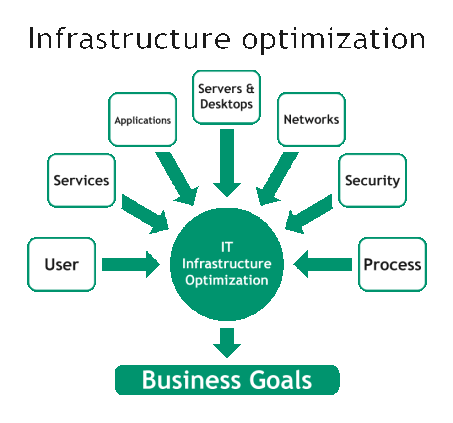
In today’s fast-paced technological landscape, businesses heavily rely on their IT infrastructure to operate efficiently and effectively. An optimized IT infrastructure allows organizations to streamline processes, maximize productivity, and minimize downtime. With continuous advancements in technology, it is imperative for businesses to constantly evaluate and enhance their IT infrastructure to stay ahead of the game.
Evaluating the Current IT Infrastructure
Before embarking on the journey of optimization, it is crucial to assess the current state of your IT infrastructure. This evaluation helps identify bottlenecks, vulnerabilities, and areas of improvement. Conducting a comprehensive audit led by IT professionals can provide valuable insights into the existing system’s strengths and weaknesses.
Identifying Key Areas for Improvement
Once the evaluation is complete, it’s time to identify key areas where optimization can enhance efficiency. This could encompass hardware, software, network infrastructure, data storage, security protocols, or even employee training. Each aspect plays a vital role in creating a robust and seamless IT ecosystem.
Hardware and Software
Outdated hardware and software not only hampers productivity but also puts data security at risk. Upgrading components like servers, storage devices, and workstations can significantly improve system performance and reliability. Similarly, using the latest software versions, utilizing cloud-based services, and implementing automation tools contribute to overall efficiency.
Network Infrastructure
A robust and scalable network infrastructure is the backbone of any IT ecosystem. Optimizing your network infrastructure involves evaluating bandwidth requirements, ensuring proper cabling and connectivity, and implementing effective network management protocols. This enhances data transfer speeds, reduces latency, and ensures seamless communication across different departments.
Data Storage and Management
As businesses grow, so does their data. Proper data storage and management are crucial for maintaining information accessibility, integrity, and security. Implementing effective storage solutions such as network-attached storage (NAS) systems and data backup strategies ensures data redundancy, quick retrieval, and protection against potential disasters.
Security Protocols
With cyber threats becoming more sophisticated, robust security protocols are essential. This includes implementing firewalls, intrusion detection systems, and encryption protocols. Conducting regular vulnerability assessments, creating strong authentication processes, and providing cybersecurity training to employees greatly reduces the risk of data breaches and protects sensitive business information.
Employee Training
No matter how optimized your IT infrastructure is, it is only as strong as the capabilities of your employees. Regular training sessions focusing on best practices, security awareness, and efficient utilization of technology can significantly enhance productivity and ensure everyone knows how to leverage the optimized IT infrastructure to its fullest potential.
Implementing Optimization Strategies
Once the key areas for improvement have been identified, a comprehensive plan should be devised to implement the optimization strategies.
Setting Clear Goals
Begin by setting achievable and measurable goals. This could include reducing system downtime, increasing network speed, improving data security measures, or streamlining workflow processes. Establishing clear objectives helps in tracking progress and evaluating the effectiveness of the optimization efforts.
Collaboration with IT Professionals
Engaging with IT professionals who specialize in infrastructure optimization is highly recommended. Their expertise and experience ensure that the optimization plan aligns with industry best practices and minimizes potential risks. IT professionals can aid in selecting the right hardware, software, and implementation procedures, ensuring a seamless optimization process.
Phased Approach
Optimizing the entire IT infrastructure at once can be overwhelming and disrupt day-to-day operations. Instead, it is prudent to adopt a phased approach where changes are implemented gradually. This allows for testing, monitoring, and fine-tuning at each step, ensuring a smooth transition.
Regular Monitoring and Evaluation
Optimization is an ongoing process and not a one-time task. It is critical to continuously monitor and evaluate the performance of the optimized infrastructure. Feedback from employees, system analytics, and IT experts can provide invaluable insights into areas that require further improvement or adjustment. Regular check-ups and evaluations ensure that the IT infrastructure stays efficient and up-to-date.
The Benefits of IT Infrastructure Optimization
Optimizing your IT infrastructure offers numerous benefits that can boost your business’s overall efficiency and productivity.
Improved System Performance
By upgrading hardware, software, and enhancing network infrastructure, optimized IT systems offer better performance with reduced downtime. Faster data transfer speeds and streamlined processes allow employees to work seamlessly, enabling them to focus on core business activities rather than grappling with technology-related issues.
Enhanced Data Security
A well-optimized IT infrastructure implements robust security measures that safeguard critical data from cyber threats. By regularly updating software, implementing firewalls and encryption, conducting vulnerability assessments, and training employees, businesses can mitigate the risks of data breaches and potential financial and reputational damages.
Increased Scalability and Flexibility
Optimizing IT infrastructure allows businesses to scale and adapt to changing needs efficiently. With cloud-based services and scalable storage solutions, organizations can rapidly expand their operations without facing significant IT-related hurdles. Flexibility in terms of remote work, data accessibility, and technology integration fosters a dynamic work environment.
Cost Savings
An optimized IT infrastructure results in cost savings in the long run. Efficient systems have reduced downtime, fewer repair and maintenance needs, and prevent expensive repercussions caused by data breaches or system failures. Streamlined processes also lead to increased productivity, saving both time and money.
In Conclusion
An efficient and optimized IT infrastructure is the backbone of any successful organization in the tech realm. By consistently evaluating and enhancing hardware, software, network infrastructure, data storage, security protocols, and employee training, businesses can achieve improved system performance, enhanced data security, increased scalability, and cost savings. Regular monitoring and evaluation ensure that the IT infrastructure remains efficient and continually adapts to emerging technologies. Investing in IT infrastructure optimization is a strategic move that empowers businesses to thrive in the ever-evolving tech landscape.


